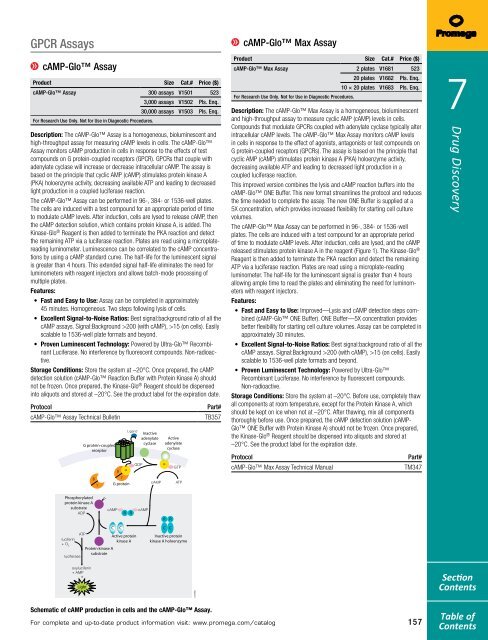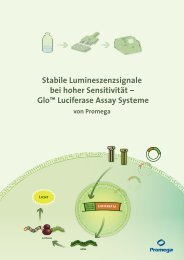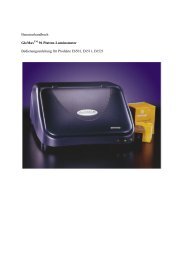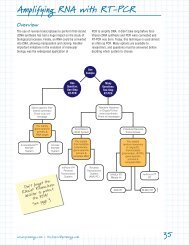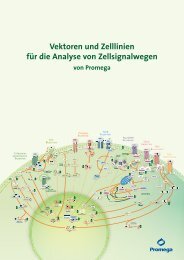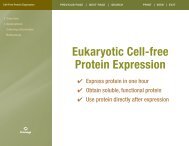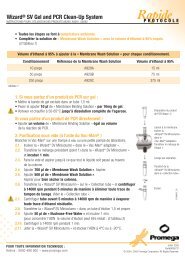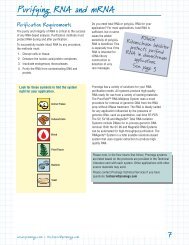2013 Promega catalogue
2013 Promega catalogue
2013 Promega catalogue
You also want an ePaper? Increase the reach of your titles
YUMPU automatically turns print PDFs into web optimized ePapers that Google loves.
Cell Signaling<br />
GPCR Assays<br />
cAMP-Glo Assay<br />
Product Size Cat.# Price ($)<br />
cAMP-Glo Assay 300 assays V1501 523<br />
For Research Use Only. Not for Use in Diagnostic Procedures.<br />
3,000 assays V1502 Pls. Enq.<br />
30,000 assays V1503 Pls. Enq.<br />
Description: The cAMP-Glo Assay is a homogeneous, bioluminescent and<br />
high-throughput assay for measuring cAMP levels in cells. The cAMP-Glo<br />
Assay monitors cAMP production in cells in response to the effects of test<br />
compounds on G protein-coupled receptors (GPCR). GPCRs that couple with<br />
adenylate cyclase will increase or decrease intracellular cAMP. The assay is<br />
based on the principle that cyclic AMP (cAMP) stimulates protein kinase A<br />
(PKA) holoenzyme activity, decreasing available ATP and leading to decreased<br />
light production in a coupled luciferase reaction.<br />
The cAMP-Glo Assay can be performed in 96-, 384- or 1536-well plates.<br />
The cells are induced with a test compound for an appropriate period of time<br />
to modulate cAMP levels. After induction, cells are lysed to release cAMP, then<br />
the cAMP detection solution, which contains protein kinase A, is added. The<br />
Kinase-Glo ® Reagent is then added to terminate the PKA reaction and detect<br />
the remaining ATP via a luciferase reaction. Plates are read using a microplatereading<br />
luminometer. Luminescence can be correlated to the cAMP concentrations<br />
by using a cAMP standard curve. The half-life for the luminescent signal<br />
is greater than 4 hours. This extended signal half-life eliminates the need for<br />
luminometers with reagent injectors and allows batch-mode processing of<br />
multiple plates.<br />
Features:<br />
• Fast and Easy to Use: Assay can be completed in approximately<br />
45 minutes. Homogeneous. Two steps following lysis of cells.<br />
• Excellent Signal-to-Noise Ratios: Best signal:background ratio of all the<br />
cAMP assays. Signal:Background >200 (with cAMP), >15 (on cells). Easily<br />
scalable to 1536-well plate formats and beyond.<br />
• Proven Luminescent Technology: Powered by Ultra-Glo Recombinant<br />
Luciferase. No interference by fluorescent compounds. Non-radioactive.<br />
Storage Conditions: Store the system at –20°C. Once prepared, the cAMP<br />
detection solution (cAMP-Glo Reaction Buffer with Protein Kinase A) should<br />
not be frozen. Once prepared, the Kinase-Glo ® Reagent should be dispensed<br />
into aliquots and stored at –20°C. See the product label for the expiration date.<br />
Protocol<br />
cAMP-Glo Assay Technical Bulletin<br />
G protein-coupled<br />
receptor<br />
β<br />
γ<br />
GDP<br />
β α<br />
γ<br />
G protein<br />
Ligand<br />
Inactive<br />
adenylate<br />
cyclase<br />
cAMP<br />
Active<br />
adenylate<br />
cyclase<br />
α<br />
GTP<br />
ATP<br />
Part#<br />
TB357<br />
cAMP-Glo Max Assay<br />
Product Size Cat.# Price ($)<br />
cAMP-Glo Max Assay 2 plates V1681 523<br />
20 plates V1682 Pls. Enq.<br />
10 × 20 plates V1683 Pls. Enq.<br />
For Research Use Only. Not for Use in Diagnostic Procedures.<br />
Description: The cAMP-Glo Max Assay is a homogeneous, bioluminescent<br />
and high-throughput assay to measure cyclic AMP (cAMP) levels in cells.<br />
Compounds that modulate GPCRs coupled with adenylate cyclase typically alter<br />
intracellular cAMP levels. The cAMP-Glo Max Assay monitors cAMP levels<br />
in cells in response to the effect of agonists, antagonists or test compounds on<br />
G protein-coupled receptors (GPCRs). The assay is based on the principle that<br />
cyclic AMP (cAMP) stimulates protein kinase A (PKA) holoenzyme activity,<br />
decreasing available ATP and leading to decreased light production in a<br />
coupled luciferase reaction.<br />
This improved version combines the lysis and cAMP reaction buffers into the<br />
cAMP-Glo ONE Buffer. This new format streamlines the protocol and reduces<br />
the time needed to complete the assay. The new ONE Buffer is supplied at a<br />
5X concentration, which provides increased flexibility for starting cell culture<br />
volumes.<br />
The cAMP-Glo Max Assay can be performed in 96-, 384- or 1536-well<br />
plates. The cells are induced with a test compound for an appropriate period<br />
of time to modulate cAMP levels. After induction, cells are lysed, and the cAMP<br />
released stimulates protein kinase A in the reagent (Figure 1). The Kinase-Glo ®<br />
Reagent is then added to terminate the PKA reaction and detect the remaining<br />
ATP via a luciferase reaction. Plates are read using a microplate-reading<br />
luminometer. The half-life for the luminescent signal is greater than 4 hours<br />
allowing ample time to read the plates and eliminating the need for luminometers<br />
with reagent injectors.<br />
Features:<br />
• Fast and Easy to Use: Improved—Lysis and cAMP detection steps combined<br />
(cAMP-Glo ONE Buffer). ONE Buffer—5X concentration provides<br />
better flexibility for starting cell culture volumes. Assay can be completed in<br />
approximately 30 minutes.<br />
• Excellent Signal-to-Noise Ratios: Best signal:background ratio of all the<br />
cAMP assays. Signal:Background >200 (with cAMP), >15 (on cells). Easily<br />
scalable to 1536-well plate formats and beyond.<br />
• Proven Luminescent Technology: Powered by Ultra-Glo<br />
Recombinant Luciferase. No interference by fluorescent compounds.<br />
Non-radioactive.<br />
Storage Conditions: Store the system at –20°C. Before use, completely thaw<br />
all components at room temperature, except for the Protein Kinase A, which<br />
should be kept on ice when not at –20°C. After thawing, mix all components<br />
thoroughly before use. Once prepared, the cAMP detection solution (cAMP-<br />
Glo ONE Buffer with Protein Kinase A) should not be frozen. Once prepared,<br />
the Kinase-Glo ® Reagent should be dispensed into aliquots and stored at<br />
–20°C. See the product label for the expiration date.<br />
Protocol<br />
cAMP-Glo Max Assay Technical Manual<br />
Part#<br />
TM347<br />
7<br />
Drug Discovery<br />
Phosphorylated<br />
protein kinase A<br />
substrate<br />
ADP<br />
P<br />
cAMP<br />
R<br />
R<br />
cAMP<br />
R<br />
R<br />
C C<br />
ATP<br />
Active protein<br />
luciferin<br />
kinase A<br />
+ O 2<br />
Protein kinase A<br />
substrate<br />
luciferase<br />
C C<br />
Inactive protein<br />
kinase A holoenzyme<br />
oxyluciferin<br />
+ AMP<br />
+<br />
Light<br />
6127MA<br />
Section<br />
Contents<br />
Schematic of cAMP production in cells and the cAMP-Glo Assay.<br />
For complete and up-to-date product information visit: www.promega.com/catalog<br />
157<br />
Table of<br />
Contents


